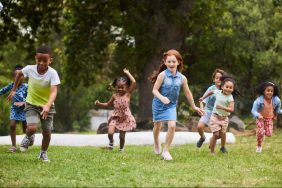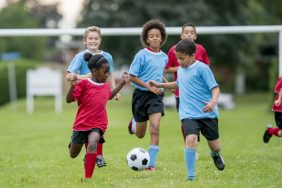Hide your kids, because according to a number of Canadian schools, they’re no longer safe on the playground. The culprit?
Physical activity.
That’s right. According to a number of different Canadian schools, physical activity and play is dangerous, and having fun at recess should no longer be allowed. It seems the “Playground Police” (those that would rather kids not engage in any fun or potentially “risky” activity while at school) are alive and well within the Canadian school system.
Various schools across Canada have started making play during recess nearly impossible. Schools have banned playing with balls, hands-on play (including games like tag), and a variety of other activities and items (including umbrellas!) that could result in bumps or bruises or even hurt feelings. Kids are afraid to move, lest they get in trouble for inappropriate playground behaviour.
What makes the actions of the Playground Police exceptionally baffling is the results of ParticipACTION’s latest report card on our kids’ health and physical wellness. It reports that kids in Canada are becoming increasingly inactive. ParticipACTION—through independent studies supported by numerous national organizations—gave a Canadian kids a failing grade (a D minus, in fact!) in the categories of Sedentary Activities and Overall Physical Activity.
According to their research, only 9% of Canadian kids ages 5 to 17 meet the physical guidelines of sixty minutes of heart-pumping activity each day.
What does that mean? It means that our kids aren’t moving, and their physical fitness is almost nonexistent.
For most of us parents and educators, it’s common knowledge that our children need to sit less and move more. If you’re anything like me, you are trying to make physical activity a noticeable priority in your family. I try to mitigate our culture of sitting by enrolling my kids in after-school/weekend sports, taking daily trips to a nearby park, or forcing them outside on after-dinner walks and bike rides. But it’s not easy, and I will admit that I could do a much better job of giving my boys free playtime.
I will also shamefully admit that I too, police my children’s playtime.
They’re rarely left alone to play without my input, and the boundaries they are given are generally limiting when it comes to exploration. According to ParticipACTIONS’s research, that’s an issue. In their report card they write:
“What many parents recall from their childhoods as thrilling and exciting play is often called ‘risky play’ these days. These are the active games and independent play that tested boundaries and included things like exploring the woods, rough housing, moving fast or playing at heights. We are not suggesting that children be reckless, but we do recognize that some risk is actually good for kids.”
And the biggest risk for our kids? Keeping them indoors. That’s what makes the playground rules implemented by some Canadian schools so utterly baffling.
Recess growing up for me was full of tag, red rover, hopscotch, skipping, and general tomfoolery. My kids don’t have that kind of recess anymore. If kids can’t play with respectable freedom during recess, what’s the point of recess at all?
The latest victim of the Canadian playground police? Cartwheels. The cartwheel is allegedly a dangerous weapon on the school playground. Once considered an integral part of any gymnastics routine, it is now deemed unsafe by one Toronto school and as a result was not permitted during recess.
According to the principal of the school that banned cartwheels, the staff was nervous about the risk that gymnastics posed during recess time. This leads me to wonder: what would a risk-free recess look like? Or even a risk-free childhood? My guess is it would look like a recess where no fun is had at all, no screams are heard, there’s no running around, and kids are forced to be completely inactive. Is that what we really want?
Yes, we can control how much risk is involved, but they need to be given the freedom necessary to play and explore and expand their physical limits. They might get hurt from time to time—some might even get injured at school—but at least it will be because they were trying something new and discovering their own abilities and boundaries.
Cartwheels are not truly risky. Neither are balls or running games. By and large, the play that our kids engage in on the playground is not unsafe—it’s fun and it’s childhood.
I’ll be the first to admit that giving my kids the freedom to play how they choose is somewhat scary. But I don’t want my kids to be so sedentary that physical activity is just not part of their everyday life. As much as it pains me to say this, there’s going to be potential for harm in vigorous activity and exercise—and we shouldn’t stand in the way of that.
Perhaps reading and implementing the recommendations and guidelines from ParticipACTION is a start, but so is ensuring that our schools and us, as parents, are not coddling our children so much that they are unable to engage in physical activity and play.
In our family, I’ll have to practice what I preach a bit more and remove the bubble wrap from my kids’ playtime. These school bans have gone too far, and they’ve given me perspective on how I’ll treat their after school play: with a bit more freedom, and a bit more risk.
image: Getty/PeopleImages.com
More Parenting in the News:








